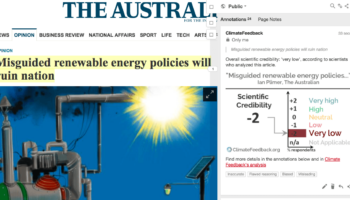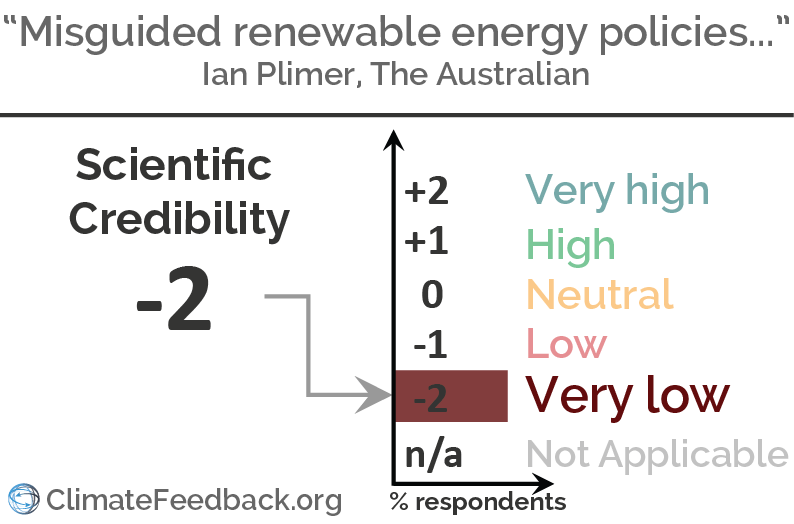- Climate
Commentary in The Australian ignores evidence and misrepresents research while falsely claiming humans are not responsible for climate change
Reviewed content

Headline: "Misguided renewable energy policies will ruin nation"
Published in The Australian, by Ian Plimer, on 2017-10-23.

Scientists’ Feedback
SUMMARY
This opinion in The Australian by Ian Plimer repeats a number of false but common claims to support an argument that human activities are not responsible for climate change, and that renewables like wind and solar cannot effectively replace fossil-fuel-burning power plants.
The scientists who reviewed this article found that it lacks scientific credibility. They explain that the author either ignores or is unaware of the abundance of scientific research that directly contradicts his claims about the cause of global warming.
See all the scientists’ annotations in context
REVIEWERS’ OVERALL FEEDBACK
These comments are the overall opinion of scientists on the article, they are substantiated by their knowledge in the field and by the content of the analysis in the annotations on the article.

Associate Professor, Yale University
This article is full of scientific inaccuracies and reveals a weak understanding of energy technologies and markets.

Assistant Professor, University of Minnesota
Yet another in the exhausting heap of opinions choosing not to engage with evidence, while still expecting readers to believe inaccurate and baseless claims. It is baffling why publications such as The Australian wish to promote opinions that are both not well-argued and demonstrably not based on fact.

Postdoctoral research fellow, University of Antwerp
The article is full of incorrect information and flawed, misleading reasoning.

Independent Research Fellow, Imperial College London
An article that either chooses to ignore scientific arguments, or to take them out of context in order to misuse them. Could not find scientifically accurate and well backed-up claims.

Researcher, Royal Netherlands Institute for Sea Research (NIOZ)
This article is misleading and ignores vast bodies of scientific research on climate change. It uses clearly incorrect statements and/or flawed reasoning to argue in favor of the authors’ opinion on climate change and energy policies.

Postdoctoral research fellow, University of Washington
The article is full of false statements, many of which have been rebutted multiple times.

Research scientist, CNRS, Laboratoire des Sciences du Climat et de l'Environnement (LSCE)
The article is misleading and presents inaccurate arguments that have no scientific support in the literature.
Notes:
[1] See the rating guidelines used for article evaluations.
[2] Each evaluation is independent. Scientists’ comments are all published at the same time.
Key Take-aways
The statements quoted below are from the article; comments and replies are from the reviewers.
“Global human emissions are only 3 per cent of total annual emissions.”

Postdoctoral research fellow, University of Antwerp
Global human emissions are indeed only a small percentage of what ecosystems cycle, but the reasoning is completely flawed. Regarding the impact on climate, it is the net emissions that matter, not the amount of carbon that is being cycled over and over. Terrestrial ecosystems take up and re-emit about 12 times more CO2 than humans emit, and oceans cycle about 9 times more CO2 than we emit. BUT! This carbon uptake and release is more or less balanced at the annual scale, and net ecosystem emissions are even negative. Without these ecosystems, atmospheric CO2 concentration would have risen even more as a consequence of fossil fuel burning; the CO2 concentration in the air would already be around 550 ppm (instead of the current ~400 ppm). Hence, it is absolutely misleading to compare amounts of CO2 cycling through the ecosystems with human CO2 emissions in this context. If anything, the CO2 cycling through the ecosystems should be taken as a reason to safeguard them: if we lose these carbon sinks, CO2 in the air will increase no matter what we do.

Group Leader, Max Planck Institute for Biogeochemistry
This is purposely misleading. Others have commented appropriately. The global carbon budget provides an overview of sources and sinks of CO2 since 1880.
Source: Global Carbon Project

Independent Research Fellow, Imperial College London
Others have already commented on this in detail. Just to emphasize: the statement is clearly misleading. What matters here is how human emissions drive the net atmospheric CO2 budget (emissions minus uptake) out of balance, which leads to an accumulation of CO2 in the atmosphere.
“It has never been shown that human emissions of carbon dioxide drive global warming.”

Independent Research Fellow, Imperial College London
This sentence essentially ignores many thousands of studies that provide evidence to the contrary (i.e., that human CO2 emissions ARE driving global warming) and is therefore factually wrong.
- IPCC (2013) Climate Change 2013: The Physical Science Basis

Professor, Directeur de Recherche, Mediterranean Institute for Biodiversity and Ecology (IMBE)
Virtually all statements in this article have been proven wrong so many times by scientific experts that it is unreasonable to once again show that they are wrong. But I want to focus on the statement “it has never been shown” only. How can one claim that the impact of anthropogenic greenhouse gas emissions has “never been shown that…”? Clearly, for this author, science per se either does not exist or else has no credibility whatsoever. Surely then, scientific research itself cannot exist, there is no geology to find coal resources, no studies “of natural processes such as ocean degassing”, etc. From this, one can only conclude that we actually cannot know anything—not even the things that this author believes to be true.

Researcher, Royal Netherlands Institute for Sea Research (NIOZ)
This is not true. In fact, there is a vast body of work on detection and attribution, which specializes in exactly this: determining the causes of observed changes in climate. This happens in a two-step process. Step 1 (the detection step) looks at whether observed changes can be explained by internal climate variability. If the answer is no, step 2 (the attribution step) determines which factors explain the observed changes.
“natural processes such as ocean degassing, volcanoes, natural chemical reactions and exhalation don’t drive global warming.”

Assistant Professor, University of Minnesota
Here is a great illustration of how these processes don’t drive warming over the observational period: https://www.bloomberg.com/graphics/2015-whats-warming-the-world/
“In the geological past, Earth’s atmosphere had hundreds of times the CO2 content of the modern atmosphere yet there were no carbon dioxide-driven catastrophes. The past shows that climate change is normal, that warmer times and more atmospheric carbon dioxide have driven biodiversity and that cold times kill.”

Independent Research Fellow, Imperial College London
There are many problems with this statement, starting with an entire lack of accuracy. It reads like a series of generic statements that can easily be taken out of context and are entirely irrelevant to the problem at hand. One particularly striking point is the implicitly obvious lack of awareness for timescales. Atmospheric CO2 concentrations are changing at unprecedented rates now, posing a serious threat to biodiversity in rapidly changing ecosystems.

Researcher, Royal Netherlands Institute for Sea Research (NIOZ)
Indeed, climate change is normal, but there are 2 important differences with respect to the geological record: 1) the current rate of increase in CO2 is unprecedented and 2) the current CO2 increase is caused by human emissions.
“Ice core drilling shows that 800 years after natural warming, the atmosphere increases in carbon dioxide”

Research scientist, CNRS, Laboratoire des Sciences du Climat et de l'Environnement (LSCE)
Recent work* shows that the temperature and CO2 rise were synchronous within uncertainties: if there was a lag it was less than 400 years, not 800 years as previously thought. Additionally, the temperature increase over the deglaciation cannot be explained solely by orbitally driven insolation changes (modifications of solar energy received by the Earth due to its position). The radiative effect of the CO2 rise amplifies the warming and explains part of the total deglacial warming.
- Parrenin et al (2013) Synchronous Change of Atmospheric CO2 and Antarctic Temperature During the Last Deglacial Warming, Science
“Instrumental temperature measurements over the past 150 years show no correlation between human emissions of CO2 and temperature.”

Founder & Executive Director, Science Feedback
Plotting the relationship between global temperature and the logarithm of atmospheric CO2 concentration shows a strong relationship (figure below). This is predicted by physics* since CO2 is a greenhouse gas. Ian Plimer might be confusing CO2 emissions and CO2 concentration in the atmosphere, which is what matters for explaining Earth’s surface temperature.
Figure – Global temperature from Berkeley Earth’s dataset versus atmospheric CO2 concentrations.
- Huang and Shahabadi (2014) Why logarithmic? A note on the dependence of radiative forcing on gas concentration, Journal of Geophysical Research Atmospheres

Assistant Professor, University of Minnesota
Instrumental temperature measurements over the last 150 years record weather/climate that is influenced by more than ONLY CO2. Natural variation must also be considered, including semi- to multi-decadal processes involving the ocean and atmosphere (e.g. El Niño-Southern Oscillation).
“On all timescales it can be shown that there is no correlation between CO2 emissions and global warming.”

Assistant Professor, University of Minnesota
This is simply false. Ice cores show correlation over ice age cycles (100,000 years).
The modern observational record shows correlation that cannot be reproduced without including greenhouse gases (CO2, CH4, N2O). Climate models demonstrate this correlation very well. If you include only natural climate forcing (volcanoes, solar variations, etc.) over the observational period, models UNDERpredict observed temperatures. If you include only greenhouse gas forcing over the observational period, models OVERpredict observed temperatures. If you include natural, greenhouse gas, and other anthropogenic forcings (including cooling effects of coal/soot pollution particulates), models quite accurately match observations.
Comparison between global mean surface temperature anomalies (°C) from observations (black) and AOGCM simulations forced with (a) both anthropogenic and natural forcings and (b) natural forcings only.
Source: IPCC
“The worldwide temperature record has been changed. Cooling trends have been ‘homogenised’ to warming trends. In the corporate world, if a loss is ‘homogenised’ to a profit, it is fraud.”

Assistant Professor, University of Minnesota
This point has been refuted ad nauseam. See Zeke Hausfather’s explaination here: https://www.carbonbrief.org/explainer-how-data-adjustments-affect-global-temperature-records
Berkeley Earth independently assessed these records. The adjustments, which are necessary over 150-200 years of measurements of varying type and quality, end up reducing the warming trend over the 20th Century.

Group Leader, Max Planck Institute for Biogeochemistry
Every time new data is assimilated, the record is bound to change slightly. I think the author is referring to a discontinuity in the global temperature record around 1945 that was shown to be due to changes in the instruments after WWII*. Since this discontinuity was reported, new temperature products were corrected for instrumentation change. This is not fraud, just good science.
- Thompson et al (2008) A large discontinuity in the mid-twentieth century in observed global-mean surface temperature, Nature
“[South Australia] has the most expensive electricity in the world.”

Associate Professor, Yale University
This is misleading. It is true that prices have rapidly increased, largely due to high natural gas prices from the start-up of gas liquefaction plants. However, there are plenty of other regions within countries (note South Australia is a region within the country of Australia) with just as high or higher electricity prices. How about villages in Alaska? Small islands? This claim is just misleading.
“Unless the laws of physics are changed, solar power cannot be made more efficient.”

Associate Professor, Yale University
This is incorrect. Sure, if you use exactly the same technologies we have today there is a barrier to the efficiency of polycrystalline solar panels. But there are many other technologies in the works that can have much higher efficiency.
- Lew (2016) Research opportunities to advance solar energy utilization, Science
“Construction and maintenance of wind and solar facilities release far more carbon dioxide than they are meant to save over their working lives and they need to be supported 24/7 by coal-fired generators.”

Associate Professor, Yale University
This is completely incorrect. There are numerous studies contradicting this. For example, see a series of studies by Sally Benson at Stanford University. Frankly, both parts of this claim are absurd. Coal-fired generators are particularly poorly-suited to act as a backup for solar because they generally are very expensive to ramp up and down, so they are used almost everywhere around the world as baseload generators. Natural gas or hydro are much better suited as backup. This sentence belies a lack of understanding of energy technologies and markets.
“[Those who signed the Paris Accord] cannot change Earth’s orbit and radiation released from the sun that drive climate”

Researcher, Royal Netherlands Institute for Sea Research (NIOZ)
The problem we are dealing with here is not the radiation released from the sun, but with the amount of energy that remains in the Earth’s climate system. The amount of energy trapped in the climate system increases due to the presence of greenhouse gases in the atmosphere: rather than shooting the energy back into space, it is used to heat the climate system. Simple physical laws, that make that more greenhouse gases cause a warmer climate.
- NASA’s Earth Observatory has an extensive explanation.

Assistant Professor, University of Minnesota
This links back to the author’s earlier claim about ice cores, that they show increasing CO2 after “natural warming.” In this ancient scenario, he is correct that warming was caused by changes in Earth’s orbit around the Sun—which slightly but significantly affects the planetary energy budget. However, it is no longer the case that solely Earth’s orbit and solar radiation drive climate change. Solar energy reaching Earth has been declining for decades, as global average temperatures have continued to increase. Zeke Hausfather has nicely explained this.
“Australia’s signed a suicide note [with the Paris Accord] yet didn’t seem to notice that China, India, Indonesia and the US did not commit to reducing their large carbon dioxide emissions.”

Postdoctoral research fellow, University of Antwerp
China and India are actually changing track. They need to because their people are dying of air pollution. And of course they have also realized that renewable energy is more profitable. See here fore much more information: https://www.worldenergy.org/publications/2017/world-energy-issues-monitor-2017/
Statement taken from the full report of 2017: “China is continuing to experience rapid growth in renewable energy capacity, with the country installing 30.8 GW of new wind capacity in 2015, and with government plans in place to build an additional 30.83 GW before the end of 2016. The country’s solar capacity, too, is increasing steadily and China has already overtaken Germany to become the country with the largest cumulative solar PV capacity globally. Regarding future investment in further renewables capacity, China claims the top spot in the 2015 Climatescope project, which ranks 55 emerging economies according to their ability to attract investment in clean energy, and places second globally after the US in Ernst and Young’s 2016 Renewable Energy Country Attractiveness Index.”
“The grasslands, crops, forests and territorial waters of Australia absorb more carbon dioxide than Australia emits.”

Group Leader, Max Planck Institute for Biogeochemistry
This is not true. According to the CSIRO (see here): “Taking all fluxes together, the Australian biosphere gained carbon on average at 59 million tonnes of carbon per year (1 Mt = 1 Teragram, Tg) during the period 1990-2011. This amount is the equivalent to 62% of Australia’s emissions from fossil fuels for the same period (this calculation excludes the fossil fuel exports shown in the budget figure).”
Source: CSIRO
A thorough analysis of the Australian carbon budget can be found in Haverd et al*.
- Haverd et al (2013) The Australian terrestrial carbon budget, Biogeoscience








